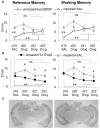Increased Hippocampal ProBDNF Contributes to Memory Impairments in Aged Mice
- PMID: 28912711
- PMCID: PMC5583170
- DOI: 10.3389/fnagi.2017.00284
Increased Hippocampal ProBDNF Contributes to Memory Impairments in Aged Mice
Abstract
Memory decline during aging or accompanying neurodegenerative diseases, represents a major health problem. Neurotrophins have long been considered relevant to the mechanisms of aging-associated cognitive decline and neurodegeneration. Mature Brain-Derived Neurotrophic Factor (BDNF) and its precursor (proBDNF) can both be secreted in response to neuronal activity and exert opposing effects on neuronal physiology and plasticity. In this study, biochemical analyses revealed that increased levels of proBDNF are present in the aged mouse hippocampus relative to young and that the level of hippocampal proBDNF inversely correlates with the ability to perform in a spatial memory task, the water radial arm maze (WRAM). To ascertain the role of increased proBDNF levels on hippocampal function and memory we performed infusions of proBDNF into the CA1 region of the dorsal hippocampus in male mice trained in the WRAM paradigm: In well-performing aged mice, intra-hippocampal proBDNF infusions resulted in a progressive and significant impairment of memory performance. This impairment was associated with increased p-cofilin levels, an important regulator of dendritic spines and synapse physiology. On the other hand, in poor performers, intra-hippocampal infusions of TAT-Pep5, a peptide which blocks the interaction between the p75 Neurotrophin Receptor (p75NTR) and RhoGDI, significantly improved learning and memory, while saline infusions had no effect. Our results support a role for proBDNF and its receptor p75NTR in aging-related memory impairments.
Keywords: BDNF; TAT-Pep5; cofilin; memory; p75NTR; proBDNF; water radial arm maze.
Figures





Similar articles
-
Aluminium oxide nanoparticles compromise spatial memory performance and proBDNF-mediated neuronal function in the hippocampus of rats.Part Fibre Toxicol. 2022 May 10;19(1):34. doi: 10.1186/s12989-022-00477-8. Part Fibre Toxicol. 2022. PMID: 35538555 Free PMC article.
-
Role of BDNF/ProBDNF Imbalance in Postoperative Cognitive Dysfunction by Modulating Synaptic Plasticity in Aged Mice.Front Aging Neurosci. 2022 Mar 18;14:780972. doi: 10.3389/fnagi.2022.780972. eCollection 2022. Front Aging Neurosci. 2022. PMID: 35370607 Free PMC article.
-
Suppression of hippocampal GABAergic transmission impairs memory in rodent models of Alzheimer's disease.Eur J Pharmacol. 2022 Feb 15;917:174771. doi: 10.1016/j.ejphar.2022.174771. Epub 2022 Jan 15. Eur J Pharmacol. 2022. PMID: 35041847
-
BDNF effects on dendritic spine morphology and hippocampal function.Cell Tissue Res. 2018 Sep;373(3):729-741. doi: 10.1007/s00441-017-2782-x. Epub 2018 Feb 15. Cell Tissue Res. 2018. PMID: 29450725 Review.
-
BDNF and Hippocampal Synaptic Plasticity.Vitam Horm. 2017;104:153-195. doi: 10.1016/bs.vh.2016.10.004. Epub 2016 Nov 29. Vitam Horm. 2017. PMID: 28215294 Review.
Cited by
-
In vivo functions of p75NTR: challenges and opportunities for an emerging therapeutic target.Trends Pharmacol Sci. 2021 Sep;42(9):772-788. doi: 10.1016/j.tips.2021.06.006. Epub 2021 Jul 29. Trends Pharmacol Sci. 2021. PMID: 34334250 Free PMC article. Review.
-
BDNF Signaling in Vascular Dementia and Its Effects on Cerebrovascular Dysfunction, Synaptic Plasticity, and Cholinergic System Abnormality.J Lipid Atheroscler. 2024 May;13(2):122-138. doi: 10.12997/jla.2024.13.2.122. Epub 2024 Feb 22. J Lipid Atheroscler. 2024. PMID: 38826183 Free PMC article. Review.
-
Dual trajectories of serum brain-derived neurotrophic factor and cognitive function in people living with HIV.Sci Rep. 2025 May 3;15(1):15520. doi: 10.1038/s41598-025-99569-6. Sci Rep. 2025. PMID: 40319152 Free PMC article.
-
Brain-Derived Neurotrophic Factor: A Key Molecule for Memory in the Healthy and the Pathological Brain.Front Cell Neurosci. 2019 Aug 7;13:363. doi: 10.3389/fncel.2019.00363. eCollection 2019. Front Cell Neurosci. 2019. PMID: 31440144 Free PMC article. Review.
-
Reversal of Cognitive Impairment in gp120 Transgenic Mice by the Removal of the p75 Neurotrophin Receptor.Front Cell Neurosci. 2019 Aug 30;13:398. doi: 10.3389/fncel.2019.00398. eCollection 2019. Front Cell Neurosci. 2019. PMID: 31543761 Free PMC article.
References
Grants and funding
LinkOut - more resources
Full Text Sources
Other Literature Sources
Research Materials
Miscellaneous

